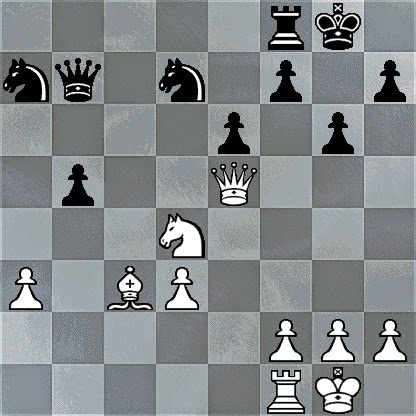Fischer vs. Spassky
Match (9), Sveti Stefan 1992
Ruy Lopez, Exchange Variation
1 e4 e5 2 Nf3 Nc6 3 Bb5 a6 4 Bxc6 The modern popularity of the Exchange
Variation stems from three games Fischer played in the Havana Olympiad 1966. It
has a small but loyal following amongst grandmasters. 4…dxc6 5 0-0 f6 6
d4 exd4 7 Nxd4 c5 8 Nb3 Qxd1 9 Rxd1 Bg4 10 f3 Be6
After 10...Be6
Black chooses a line which as regarded as one of his most solid
defenses. The preliminary …Bg4 induces White to weaken the a7-g1 diagonal,
thereby giving Black the possibility of developing his bishop at c5 with gain
of tempo. 11 Nc3 11 Bf4 c4! 12 Nd4 0-0-0 13 Nc3 Rxd4 14 Rxd4
Bc5 is one line in which Black makes use of the weakening move f3. 11…Bd6
12 Be3 b6 13 a4 0-0-0?! Although this has been played quite
frequently, it seems far risky than the two alternatives. These are the
slightly passive 13…a5 and the solid 13…Kf7 14 a5 c4 15 Nd4 b5. 14 a5
Kb7
After 14...Kb7
15 e5! The most
combative move. 15 axb6 cxb6 16 e5 is another variant of the e5 idea, which is
also important for the game as where are transpositional possibilities. After
16…Be7 17 Rxd8 Bxd8 18 Bxc5
After 18 Bxc5 (analysis)
(or 18 Ne4 Bxb3 19 Nd6+ Kc6 20 cxb3 Ne7 21 Rxa6 Bc7 22 exf6 and
White chances of exploiting the extra pawn are minimal in view of his weak
queenside pawns and Black’s active king) Black can try:
1) 18…Bxb3 19 Bf8 Ne7 20 Bxg7 Rg8 21 exf6 is very
good for White.
2) 18…Nh6 19 Nd4 Bd7 20 Bd6 Re8 (20…Nf7 21 e6!)
21 e6! Bxe6 22 Re1 Bd7 23 Rxe8 Bxe8 24 Bf8 wins a pawn.
3) 18…fxe5! 19 Bf8 (after 19 Bd6 Bf6 20 Re1 Bxb3!
21 cxb3 Nh6 22 Bxe5 Re8 23 Bg3 Rxe1+ 24 Bxe1 Nf5 we again have the situation
where White’s chances of exploiting the extra pawn are not all the great in
view of his weakened queenside pawns and Black’s active pieces) 19…Bf6 20 Ne4
Bxb3 21 Nxf6 Nxf6 22 Bxg7 Rg8 23 Bxf6 Bd5 and again White will have trouble
making use of the extra pawn, e.g. 24 Kf2 e4 25 Rd1 Bc6 26 f4 e3+ 27 Kxe3 Rxg2.
15…Be7 15…fxe5 is bad;
for example, 16 axb6 cxb6 17 Ne4 Bxb3 (17…Be7 18 Rxd8 Bxd8 19 Nbxc5+ wins) 18
Nxd6+ Kc6 19 cxb3 Rxd6 20 Rxd6+ Kxd6 21 Rxa6 Nf6 22Rxb6+ Kd5 23 Rb7 and White
is clearly better. 15…Bxb3 is also inadequate after 16 exd6 Bxc2 17 Rdc1 Bg6 18
dxc7. 16 Rxd8 Bxd8 17 Ne4
After 17 Ne4
Intending 18 Nbxc5+. 17…Kc6? Spassky makes a
serious mistake and loses quickly. The alternatives are:
1) 17…Bxb3 18 cxb3 Ne7 19 axb6 cxb6 20 exf6 (20
Nd6+ Kc6 transposes into the 18 Ne4 bracket in the note to White’s 15th move) 20…gxf6 21 Rd1 (both 21 Nd6+ Kc6 22 Nf7
Rf8 23 Nxd8 Rxd8 24 Rxa6 Rd3 and 21 Nxf6 Nf5 22 Nd5 Nxe3 23 Nxe3 Nf6 are fine
for Black) 21…Nf5 22 Bf2 with just an edge for White.
2) 17…Be7! 18 axb6 (18 Bxc5 Bxb3 19 Bxe7 Nxe7 20
cxb3 fxe5 21 axb6 Kxb6 with equality) 18…Bxb3 19 cxb3 cxb6 20 Rd1 (20 Nd6+ Bxd6
21 exd6 Nh6 22 Bxh6 gxh6 should be a draw) 21 Rd7+ Kc8 22 Ra7 Kb8 23 Rd7 Kc8 is
level.
18 axb6 cxb6
After 18...cxb6
If 18…Bxb3, then 19 b7 Kxb7 20 Nxc5+ Kb8 21 cxb3 fxe5 22
Nxa6+ wins. 19 Nbxc5 Crushing. 19…Bc8 Or
19…bxc5 20 Rxa6+ Kd5 21 Nxc5 Bf7 22 Rd6+. 20 Nxa6 fxe5 21 Nb4+
After 21 Nb4+ 1-0
1-0 The end might be
21…Kb5 (21…Kc7 22 Ra7+ Bb7 23 Rxb7+ Kxb7 24 Nd6+ wins) 22 Nd6+! Kxb4 23 Ra3 and
24 c3#.
Source from:
GAMBIT: John Nunn’s 101 Brilliant Chess Miniatures (Pages 113 -
114)
#FischerVsSpassky
#chess
#chessmatches
#chessbrilliancy
#chessminiature
#chessnovelty
#chesslesson
#chesstutorial
#chesstactics
#chesstechniques





.jpg)

































